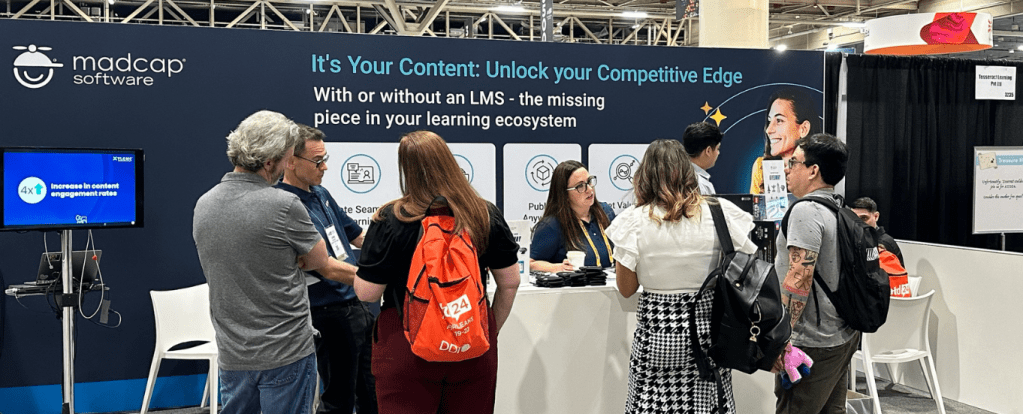
Maria McGinn
Area Vice President, Xyleme
In order to keep up with expanding and evolving content deliverables and delivery channels, you have to modernize the tech stack that supports your content strategy.
Technologies and platforms are emerging and evolving at record speed, yet many enterprise organizations continue to rely on traditional content libraries and management processes. Indeed, the need for content libraries isn’t going away (despite what naysayers thought would happen to books) — just as the need for Instructor Led and practicum training continues — but it is evolving.
Most organizations, for example, have augmented all this wealth of printed knowledge with digital materials, typically being deployed through learning management systems (LMSs). In fact, 90% of companies surveyed by Training Magazine in 2021 reported using an LMS for content delivery.
But as content needs and delivery channels expand and evolve, content continues to explode across different mediums as organizations strive to provide a more personalized content experience.
Josh Bersin recently shared on LinkedIn that this is “the end of the innovative LMS era.” He said what many of us are thinking, “…the technology stack is old and the LMS market has moved on.”
Mic drop.
In reading about Cornerstone’s acquisition of SumTotal, I thought about the customers I have worked with over the years as they embarked (willingly or not) into migrations and transitions from one LMS to another. While SCORM promises to enable content and tracking interoperability between systems, the interpretation of the standard has been left to the vendors. This often leads to a bit of heartburn during the migration of content. Those who know, know.
What does this mean for your proprietary content?
Odds are, your proprietary content currently lives in a lot of different places. Some of it may be on a LMS server pointing to an LMS that is now a “back office” feature managing certification training, and some of it might be on a server elsewhere. Regardless, it is likely decentralized, which presents significant challenges when you need to update, share, reuse, or otherwise manage it.
Think about where your content lives today — is it the best place for your content to live in the new landscape?
Heads up… there are better systems for content management and delivery that can arm you for the future.
I would argue that the “L” in LCMS differentiates Learning Content Management Systems (sometimes referred to as Component Content Management Systems) from other content management systems and LMSs.
IT, Learning Development and Governance Departments should consider this an opportune time to review content strategies, as well as the tech stack that supports them.
Here’s why:
- You need to control your content.
You are your own producer and publisher. That’s right — you own the content, you write the content, you publish it, and you distribute it. Your content is your intellectual property. How you manage content, copy it, reuse it, and license it, should be entirely up to you. - Technology can help mitigate your risks.
If your content is mission critical, ensuring you are delivering the correct version of content is imperative. In highly-regulated industries, supporting exact audit trails, version histories, and record keeping is a must. - Managing your outputs gives you flexibility.
Hundreds, maybe thousands of people want and need your content and you want them to have it. This presents a fantastic opportunity to manage your information for several different internal and external audiences. It also means you need to tailor your material at times and present it in various formats and through different channels. - Delivery channels will continue to expand and evolve.
We are seeing this now, and your content library has to provide a solid foundation if you want to support growth and be able to serve content to all the available channels. It makes sense to ensure you can manage it effectively. - Demand for personalization is growing.
Setting up a content strategy that includes agile development means you can properly author, manage and deliver highly tailored content experiences on demand and to any system, so you can truly future proof your content.
Without a future-proof content strategy — and the right tech stack to support it — your content can quickly spiral out of control.
It’s time to move on from the old approach, where multiple servers and administrators in different systems drop copies of your materials into a plethora of platforms. Instead, organizations can leverage technology to turn the tables, allowing platforms — any platforms — to pull content directly from your centralized content library, establishing a single source of truth and future proofing your content strategy so you can easily adapt to new technologies, audiences, and business drivers as they emerge.
With an LCMS like Xyleme, organizations can stay ahead of inevitable market changes and position themselves (and their content strategies) for long term success.

About Maria McGinn
Maria McGinn joined her first eLearning tech start-up in 2000. Having worked in many facets of learning content management including sales, marketing, project implementation and product strategy in large enterprise, Maria joins Xyleme as an Area VP working with customers in regulated industries globally.





